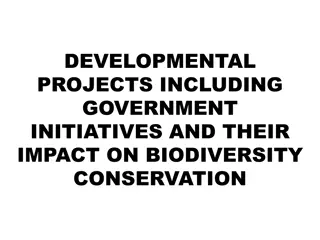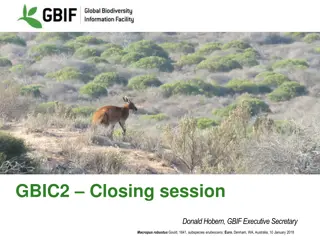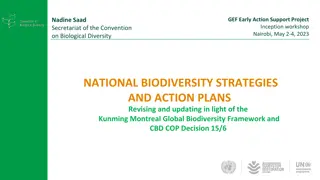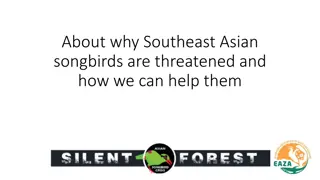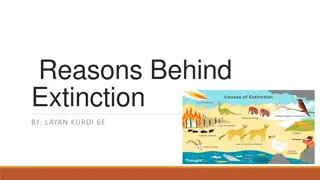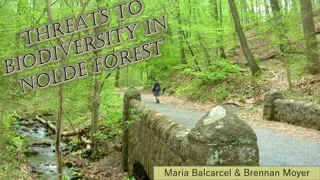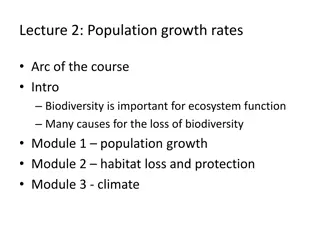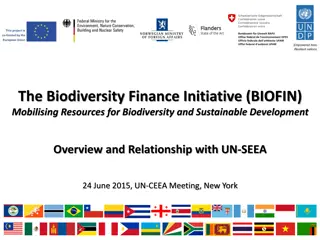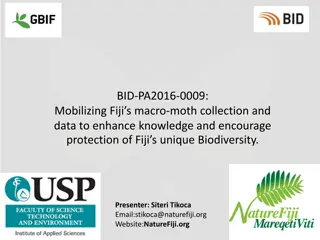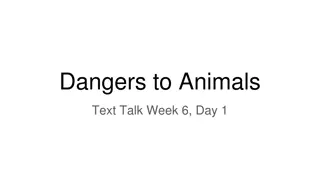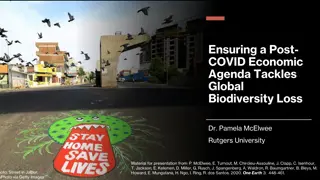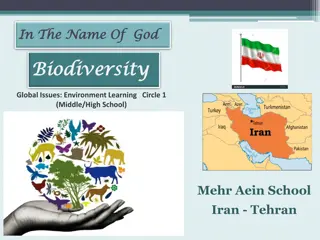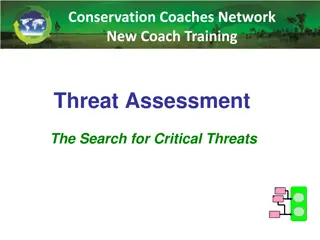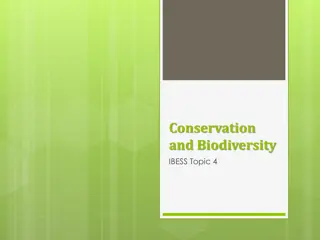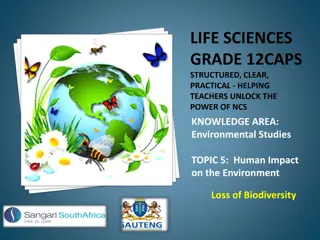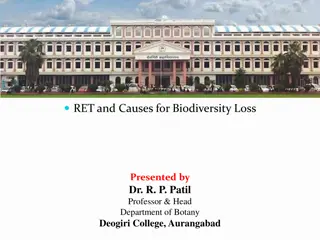Threats to Biodiversity: Habitat Loss and Conservation Efforts
Habitat loss is a significant threat to species worldwide, with forests, swamps, plains, and other habitats disappearing due to human activities. The decline of black rhinos and the conservation efforts made to protect them illustrate the impact of such activities on wildlife populations. African Parks' initiatives aim to create safe havens for black rhinos through habitat conservation and reintroduction programs. Another species, the Golden-mantled Kangaroo, faces challenges in its native habitat in New Guinea. Conservation efforts and awareness are crucial to prevent further biodiversity loss.
Download Presentation

Please find below an Image/Link to download the presentation.
The content on the website is provided AS IS for your information and personal use only. It may not be sold, licensed, or shared on other websites without obtaining consent from the author. Download presentation by click this link. If you encounter any issues during the download, it is possible that the publisher has removed the file from their server.
E N D
Presentation Transcript
Biology Project Done by: Layan Al Kurdi Alia Abu Mariam Saif Mdanat Rayan Samawi
Introduction Habitat loss poses the greatest threat to species. The world's forests, swamps, plains, lakes, and other habitats continue to disappear as they are harvested for human consumption and cleared to make way for agriculture, housing, roads, pipelines and the other hallmarks of industrial development. Without a strong plan to create terrestrial and marine protected areas important ecological habitats will continue to be lost.
Rhino Rhinos once roamed many places throughout Europe, Asia, and Africa and were known to early Europeans who depicted them in cave paintings. The most Black rhinos are the smaller of the two African rhino notable difference between white and black rhinos are their hooked upper lip. They have two horns, and occasionally a third, small posterior horn.
Populations of black rhino declined dramatically in the 20th century at the hands of European hunters and settlers. Between 1960 and 1995, black rhino numbers dropped by a sobering 98%, to less than 2,500. Since then, the species has made a tremendous comeback from the brink of extinction. Thanks to persistent conservation efforts across Africa, black rhino numbers have doubled from their historic low 20 years ago to around 5,500 today. lagued with a status of Endangered under the International Union for Conservation of Nature (IUCN) Red List since 1986, the black rhino suffered a population decline of 96% between 1970 and 1993, culminating in a status of Critically Endangered by 1996. From an estimated 100,000 black rhinos in the early 20th century, a mere 2,300 individuals remained by 1994.
African Parks is creating safe havens for black rhinos by securing national parks and protected areas where they live, and reintroducing them to safe areas where they have gone locally extinct.
THE GOLDEN MANTLED KANGAROO A species of tree-kangaroo, this animal is very similar and related to Good fellow's tree-kangaroo, sometimes even considered to be the latter's subspecies. However, the Golden-mantled tree- kangaroo is smaller, distinguished from the Good fellow's tree-kangaroo by golden shoulders, white ears as well as pinkish or lighter face. The kangaroo is native to forests of northern New Guinea, which is currently the primary habitat of the animal.
This species is on the verge of going extinct due to habitat loss brought on by poaching and deforestation. WWF strives to stop illegal logging and promotes the Forest Stewardship Council certification of wood and wood products in order to lessen habitat loss due to deforestation. another reasons why are Tree kangaroo are extinction This species is on the verge of going extinct due to habitat loss brought on by poaching and deforestation. 29 per cent of Kangaroos killed for commercial gain in NSW were female (144,212). These numbers do not include joeys killed in the process, estimated at an additional 54,000). The 2021 actual commercial kill for all Kangaroo species in NSW was 497,285 (31 per cent of heavily reduced quota), up from 469,186 in 2020 when 22 per cent of the quota was met. The actuals for 2022 are likely to prove very telling.
To reduce habitat lost through deforestation, WWF works to decrease illegal logging and supports Forest Stewardship Council certification for wood and wood products. The organization also promotes and manages protected areas for the tree kangaroo.
Rock hopper Penguin Incredible Rock hopper Penguin Facts! Some scientists split these penguins into three species (southern, northern, and eastern), while others consider them one species. They are known for their bright red eyes and bright yellow head plumage. They can dive up to 330ft in search of prey at sea. Rock hopper penguins mate for life. These penguins are found all around the southern hemisphere, from the southern coast of South America all the way to New Zealand.
Numerous seabird species have seen population losses globally as a result of anthropogenic modifications to the maritime environment and changes in the global climate. The significant population reduction of rock hopper penguins may be caused by rising sea surface temperatures (SST). Rock hopper Penguin numbers at Campbell Island have declined by 94% since the early 1940s. Many breeding colonies have disappeared and the remaining nine major colonies have all shrunk in size. We estimate there were 103 000 breeding Rock hopper Penguins in 1985, compared with approximately 1.6 million in 1942. The decline had started by 1945, was greatest during the next ten years and coincided with substantial changes in sea temperatures.
he Antarctic Treaty was signed by 12 nations in 1959 and reauthorized in 1991 to protect Antarctica and preserve its living resources. The Treaty makes it illegal to harm, or in any way interfere with, a penguin or its eggs.
Citation WWF. Rhino | Species | WWF. World Wildlife Fund, www.worldwildlife.org/species/rhino. WWF. Impact of Habitat Loss on Species. Panda.org, 2020, wwf.panda.org/discover/our_focus/wildlife_practice/problems/habitat_loss_degrada tion/. Cunningham, D. M., and P. J. Moors. The Decline of Rockhopper Penguins Eudyptes Chrysocome at Campbell Island, Southern Ocean and the Influence of Rising Sea Temperatures. Emu, vol. 94, no. 1, 1994, pp. 27 36, www.publish.csiro.au/mu/mu9940027, 10.1071/mu9940027. Accessed 9 Oct. 2022. WWF. Impact of Habitat Loss on Species. Panda.org, 2020, wwf.panda.org/discover/our_focus/wildlife_practice/problems/habitat_loss_degrada tion/. ---. Rhino | Species | WWF. World Wildlife Fund, www.worldwildlife.org/species/rhino.



